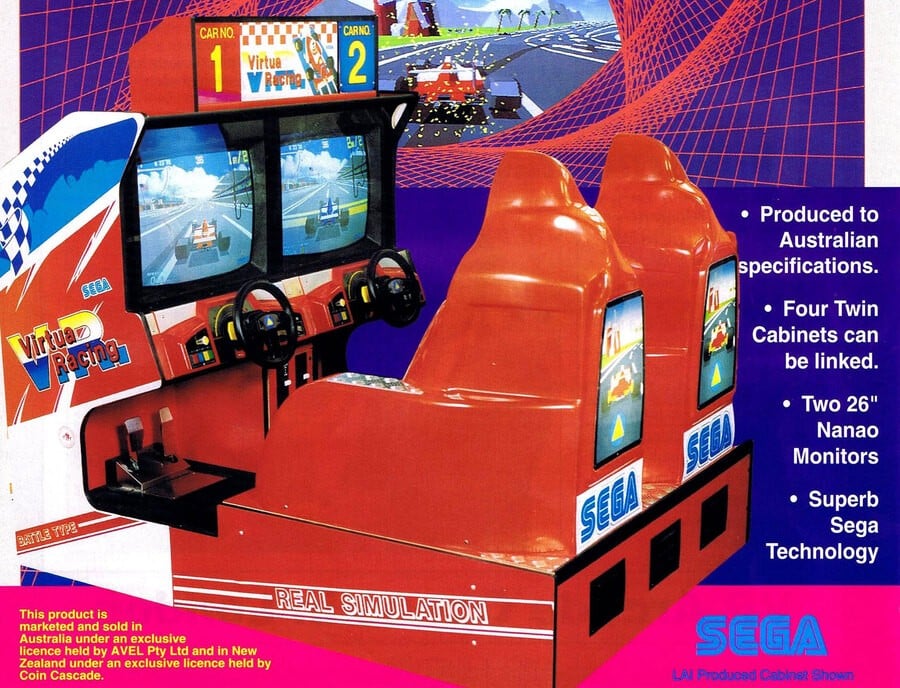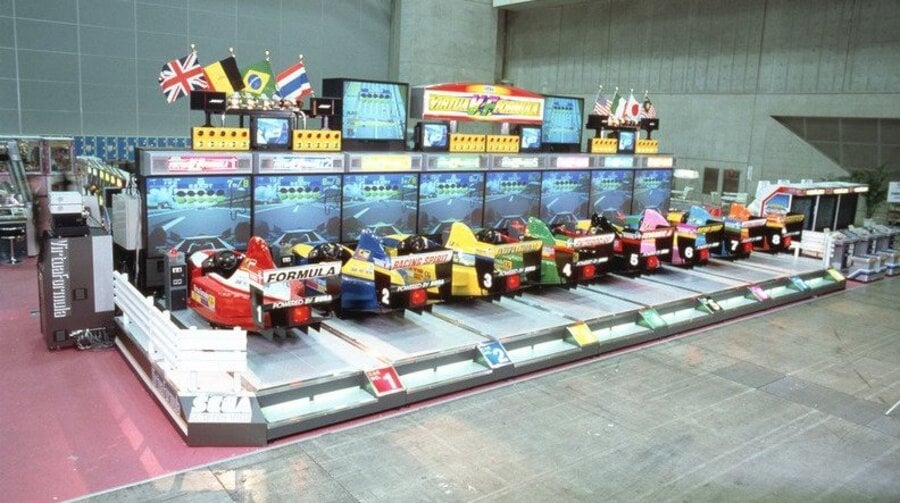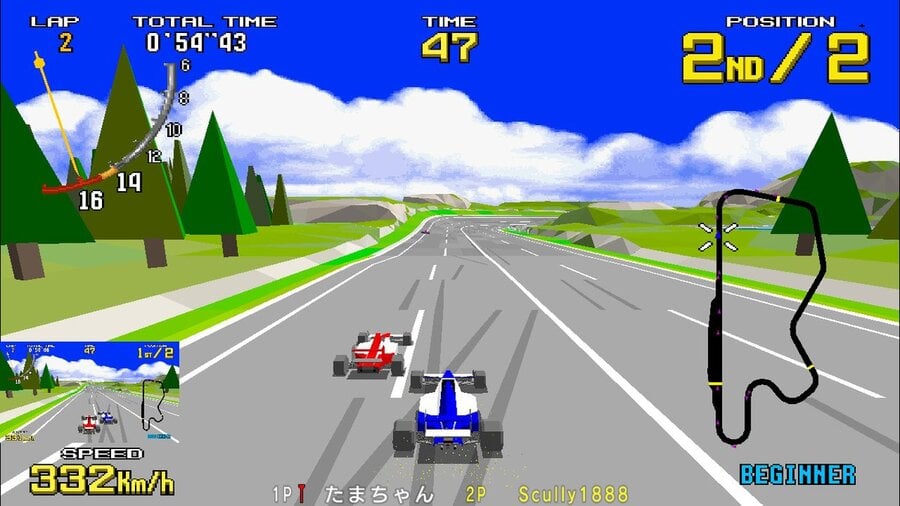
Far more than any other factor, it was undoubtedly the advent of new hardware that propelled Sega’s arcade games to a whole new level. The ‘90s saw video games make the transition from sprites to polygons, a charge Sega led from a position of uncontested leadership despite stiff challenges from rivals like Namco. Sega had been moving towards 3D games for some time, beginning with the dynamic work of creators like Makoto Uchida and Yu Suzuki. They pushed the System 16 and System 32 boards to their limits, squeezing every ounce of power they could to bring elements of the third dimension to their games.
Suzuki’s arcade track record was unmatched, and the level of success he had brought Sega had kept it a step ahead of its competition
 Watch on YouTube
Watch on YouTubeSubscribe to Nintendo Life on YouTube841k
The new decade witnessed a rise in interest in 3D games, fueled by the epic rivalry between Sega and Namco. The latter landed the first blow in the 3D racing battle in 1988 with its superb Winning Run, a Formula One game that ran on the powerful System 21 “Polygonizer” hardware. The board took three years to develop and was the first designed specifically for polygons. It served Namco as a shared development system with Atari Games, which was using it to develop Hard Drivin’. Winning Run used a more powerful incarnation of the system, which was powered by multiple processors that could push 60,000 polygons per-second.
To answer, Sega turned to Yu Suzuki. There was likely no one better within the company for the task. Suzuki’s arcade track record was unmatched, and the level of success he had brought Sega had kept it a step ahead of its competition. He was also no stranger to breaking new ground. Hang-On had pioneered the simulator game, and hits like Out Run and Space Harrier had given new life to tired genres. He wouldn’t be designing the first 3D racing title, but he was determined to make the most realistic. Suzuki was quite willing to attempt a 3D game (his undergraduate thesis had been on the subject), and he saw it as the future of video games.
Suzuki’s first thoughts turned to making a rally game, like the Dakar Rally, in which off-road vehicles traversed dunes, rocks, and other natural surfaces. Sega requested a Formula One game instead, likely to make head-to-head comparisons with Winning Run easier for consumers. He used Sega’s Model 1 arcade board, which used the same NEC V60 processor found in the System 32 hardware. The V60 was the first widely available microprocessor in Japan, and it did not have robust 3D capabilities. Contrary to popular belief, Virtua Racing began development as a full game for the Model 1 hardware. For years, stories have persisted that its origins lay in a concept demo AM2 created of a Formula One racer as a pitch to show off the capabilities of the new board. Supposedly, it so dazzled Sega executives that it was subsequently used for the actual game. Suzuki dispelled this story once and for all in a 2014 interview for Read Only Memory's Sega Mega Drive / Genesis: Collected Works, when asked if the landmark title began as a demo:
No, it was always intended to be the first full game for the Model 1. It was a very difficult project as the hardware was still in development when we began designing the game. This meant that we had to simulate the software using a PC.
Commencing development before the target platform is finalized is a common practice in the video game industry and considering the importance that Virtua Racing had for Sega, it is not surprising that AM2 went this route.
Virtua Racing was designed by Toshihiro Nagoshi, who joined Sega in 1989 as a designer in Suzuki’s AM2 division after graduating with a degree in movie production. It was his job to make his boss’s vision tangible. Nagoshi and his design team created three varied courses to show off the capabilities of the new board, each with a different level of difficulty. The Model 1 racer made ample use of the board’s new custom graphics engine, called the CG board, which could push 180,000 polygons per-second.

Virtua Racing’s strongest asset was its fluid gameplay and ability to mimic a real Formula One racing experience. There were only three tracks from which to choose and one style of car, and there was only an exhibition mode for one to eight players (if linked). What impressed the most was how it innovated by letting players change their racing perspectives. Four different views were included, and players could drive from a first-person angle or behind-the-car third person view. AM2’s work amazed those who came by the studio and saw it, something Suzuki found humorous. In a 2005 interview, he explained their reactions. “When people outside the team came to see us during the development, they found it really incredible that we could change the camera angle.”
Virtua Racing presented a much closer approximation to an actual racing experience than other games before it
Virtua Racing also employed Sega’s Air Drive System, which was available on the deluxe cabinet model. Its inclusion showed how Sega had continued to refine the technology that first appeared in Super Monaco GP. To facilitate access to the cockpit, the natural position of Virtua Racing’s seat was far back, making the area seem larger than it would be when someone was playing. As soon as players sat down and inserted their coins, however, the Air Drive System activated. Players could press buttons on the machine’s side to adjust the seat, and a driver board communicated with the game’s motherboard to activate a miniature air compressor that was mounted inside the back cabinet, behind the players’ location.
When activated, the compressor energized an air solenoid that inserted air into a long piston behind the seat, allowing players to adjust it forwards or backwards. Built into the seat were seven individual airbags. Whenever players ran their cars off the road or hit another car or part of the scenery, the air compressor inflated the corresponding airbag to simulate contact. Sega covered up the compressor by making the entire cockpit area look like part of a Formula One race car. The cabinet’s look, along with the Air Drive System, was combined with Sega’s Wide Vision Monitor, which displayed the racing action in 16:9 (a first for arcades), and a force feedback steering wheel, Virtua Racing presented a much closer approximation to an actual racing experience than other games before it.

Achieving the level of sophistication that Suzuki and Nagoshi wanted was not easy. It may have been more sophisticated than Namco’s architecture, but there were still major obstacles that had to be overcome to achieve the desired level of realism. The Model 1 board had real limitations that hampered what they had in mind. For instance, the polygon level was so low that the car’s tires could not be completely round and had to be made hexagonal in shape.
Virtua Racing was intended as a high-end machine to be sold to premier amusement centres
When it debuted in arcades in December 1992, Virtua Racing impressed the media and consumers alike with its fluid gameplay. Sega released the game in three different models, including a deluxe cockpit cabinet and twin version that fit two players side-by-side with separate monitors. Virtua Racing was intended as a high-end machine to be sold to premier amusement centres. The deluxe cabinet sold for over $25,000, and even the dedicated upright version had bells and whistles that made it very expensive. It included a seat and a 26-inch high-resolution monitor, and it could be linked to other cabinets for races with up to eight players. There were also optional “live action monitors” that could be placed above the linked cabinets to broadcast coverage from fixed locations within the game’s race track. At $1 per play, it was vital to create the most attractive experience possible, and the sight of multiple cabinets linked together was very impressive.
The impact Virtua Racing had on how Sega created its games extended beyond technical specifications and cabinet innovations. It heralded a new style of game-making that would define the company during its heyday making 3D, polygonal arcade titles. The style that many recognize as the hallmark of AM2 3D games began here, including the sound work of Koichi Namiki and Takenobu Mitsuyoshi. A classically-trained musician, Mitsuyoshi first learned of Sega when a college friend introduced him to Galaxy Force at a local arcade. Mitsuyoshi noticed how different the music sounded from the simple Mappy and Pac-Man themes of his youth. He was playing in a band at the time and wondered if it would be considered relevant experience for a job in the video game industry. He tested his luck and filled out applications to Namco, Konami, Taito, and SNK. While exploring a bit more about Sega’s music, he discovered the Sega Sound Team (SST) band.

Soon afterwards, he went to a Sega job fair. All the available openings were for administrative positions, but someone there raised their hand and inquired about working in the sound department. He was told by a Sega representative to send in a demo tape. Seeing his chance, Mitsuyoshi sent in his own job application and demo tape with two instrumental songs, hoping to become a member of SST. Sega hired him but not to join the band. He was instead assigned to write the music for the motorcycle racer, GP Rider. He later wrote the score for G-LOC, a jet fighter game that used Sega’s gargantuan R360 cabinet. It was after that project that he was finally invited to join the SST, going by the nickname “R Saburomaru” (an archaic way of saying “360,” a reference to his first work). It was there that he came to work with Namiki. The two would release several albums of music together as a duo called B-univ (short for Baby Universe), featuring songs from OutRunners, Virtua Racing, Virtua Fighter, and Daytona USA.
It became the blueprint for 3D racers to come and Sega’s rallying cry to the industry that 3D was the future
Stunning visuals, engaging gameplay, and great music combined to make Virtua Racing a winner. Even as Sega wowed players with Time Traveler, the game that many within industry thought would spearhead its development focus for the ‘90s, Sega Enterprises, Inc. president Tom Petit was already looking towards the next big thing. He knew, as Sega of Japan did, that games utilizing video footage as its main selling point didn’t have the legs to last. He’d sell it as best he could, but there was an even larger revolution coming, one that would make multimedia and full-motion video yesterday’s news. Polygonal games like Virtua Racing were Sega’s future, and he expressed that belief to distributors at the 1992 Amusement & Music Operators Association (AMOA) convention.
Virtua Racing was the consolidation of everything Suzuki and AM2 had learned dating back to Hang-On. It served as a prime example of how years of experience pushing arcade technology had forged a wide path for other companies to follow in their racing designs. More importantly, it became the blueprint for 3D racers to come and Sega’s rallying cry to the industry that 3D was the future. “Everything we are doing now and in the future with this level of sophistication,” said Tom Petit after Virtua Racing was unleashed to the world, “will not be able to be experienced at home.” Sega would continue to innovate, remaining in the vanguard of the new and exciting world of 3D arcade games. Its next racer would go above and beyond what Virtua Racing had achieved, but there will always be a place in history for what AM2 achieved, hexagonal wheels and all.
From The Sega Arcade Revolution: A History in 62 Games © 2018 Ken Horowitz by permission of McFarland & Company, Inc., Box 611, Jefferson NC 28640.
Please note that some external links on this page are affiliate links, which means if you click them and make a purchase we may receive a small percentage of the sale. Please read our FTC Disclosure for more information.





Comments 20
Great read, thanks for that! Always interesting with gaming history.
Interesting story indeed, and a very entertaining read. Credits to the original writer, and the smart man who decided to post it on NLife.
Great article, it really calls back to a time where companies were constantly trying to 1-up each other in the arcades! While I was a bit young to fully appreciate arcade games during the early 80's, watching the technology evolve from '86 through the 90's was truly mind blowing. From scalers, to shaded polys, to textured polys. From increasingly refined force feedback steering, gearboxes, shift paddles, and motion seats, to simulated anti-lock brakes and traction control. From simple microswitch or leaf switch joysticks to analog, optical and hydraulic. Hard drives that stored the game and also local player stats that later gave way to rewritable magnetic and IC embedded cards. Higher resolution monitors, full 360 degree motion cabinets, surround sound, optical light gun sensors, LED screens in scopes attached to turret mounted mockup sniper rifles! The 90's was the wildest time to be into arcade games!
Hope Sega release it soon in the west.
im excited to try this out on Switch.
I still remember the first time I saw Virtua Racing running on a Sega Genesis, I couldn't believe my eyes! I just had to get the game that day and to this day I still own that copy of the game for the Genesis. In an era before the PS1 and N64 it was about as impressive as video games got.
Come to the states already!! Cmon!
"The recent Switch port of the game is even better than the arcade original, offering 60fps, 1080p gameplay"
And also literally no visible pop-in, which is actually the most impressive part of this version.
Great article, but: "Hang-On had pioneered the simulator game" — I've gotta correct this one line. I don't think I could rightfully call Hang-On a simulator, even though the physical bike added a lot of immersion. Often when tracking console and arcade history, we forget about all the pioneering work done on computers. Although those games often lacked in flash and refinement, it was the first place you'd find true racing simulators and polygonal 3d. Virtua Racing itself is interesting in that it was a flat polygon game done at a time computers were introducing Gouraud shading and texture mapping, but it was done so artfully, and so smoothly. Now when can we get a Wing War port? ;D
Great read. I've always liked arcade racing games and Sega's old-school games, so can't wait until it comes out in the US.
Great article - the 3D revolution of the early '90s was such an exciting time as a gaming fan. This game, alongside Daytona USA and Mario 64 are the games that really stand out in my mind as those that pushed the boundaries beyond what I ever thought possible.
Why the hell can't release it worldwide at the same time is a mystery. It's a digital download. No, I'm creating a Japanese account just to buy the Jap version. Nor should I have to!
Im not sure why this decision was made. The demographic (read: sales profits) is huge in the west. I guess someone somehwere is trying to replicate the feeling of an import exclusive as were the days of yore..
I adore V.R, but Winning Run is far more impressive and it's mind blowing tyo think it released in 1988. I was happy playing Shinobi at that time.
@Jawessome @HalBailman
I think it’s the nostalgia, it’s just like the 1990s again. It wouldn’t feel right if brilliant Sega video games didn’t also come with bizarre self-harming Sega business decisions.
Man, this makes me really want a Daytona game on Switch.
What a great game - my local arcade had a 4 f1 car sit down set up. I can also recall a “real car” ridge racer set up at a London arcade. Crazy times!
Well written article and a really enjoyable read - thank you!
@louisG This excerpt is from a larger work that includes a comprehensive discussion of Sega's taikan simulator arcade games, from Hang-On all the way to the R360 and Virtua Racing. The term "simulation game" refers to those machines, not the simulator genre in general.
Oh! That makes perfect sense in that context.
Loved reading this again, and definitely work picking up the book if you're a fan of Sega's arcade days!
Show Comments
Leave A Comment
Hold on there, you need to login to post a comment...